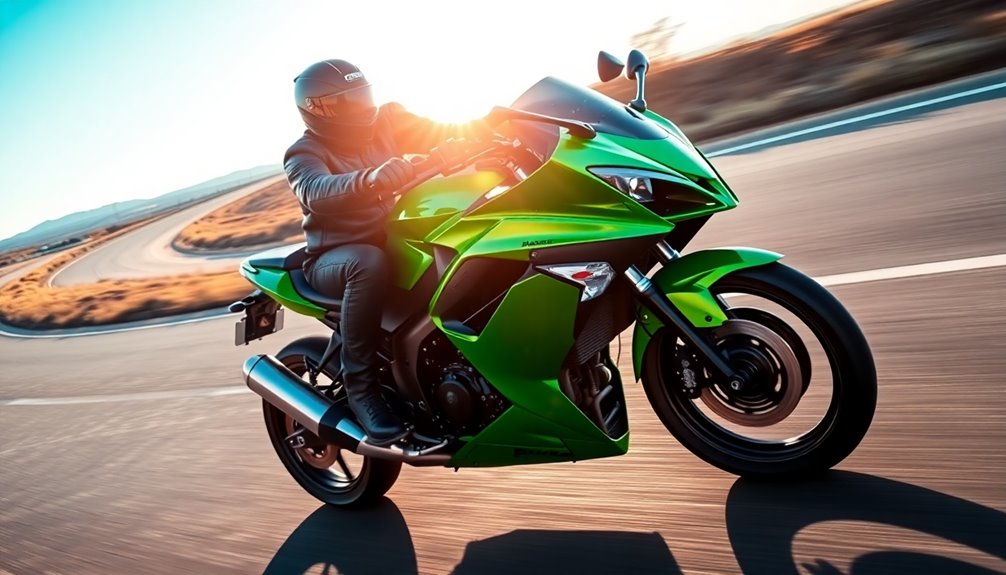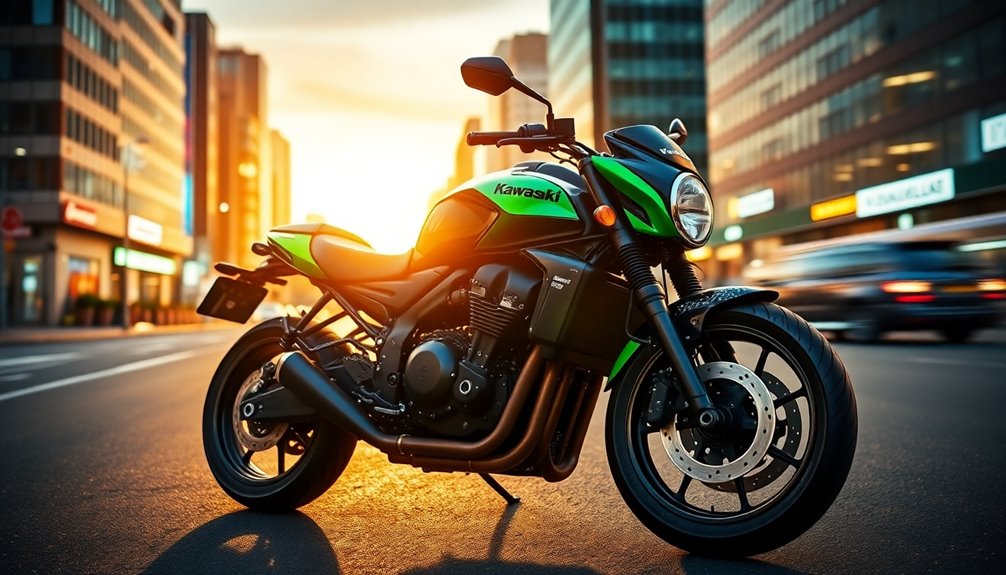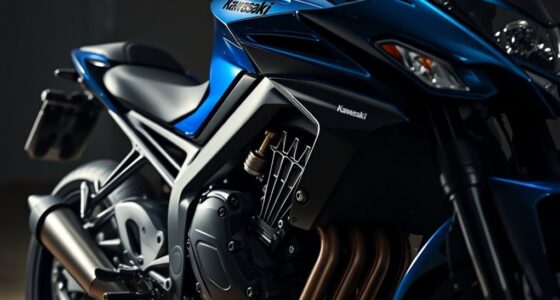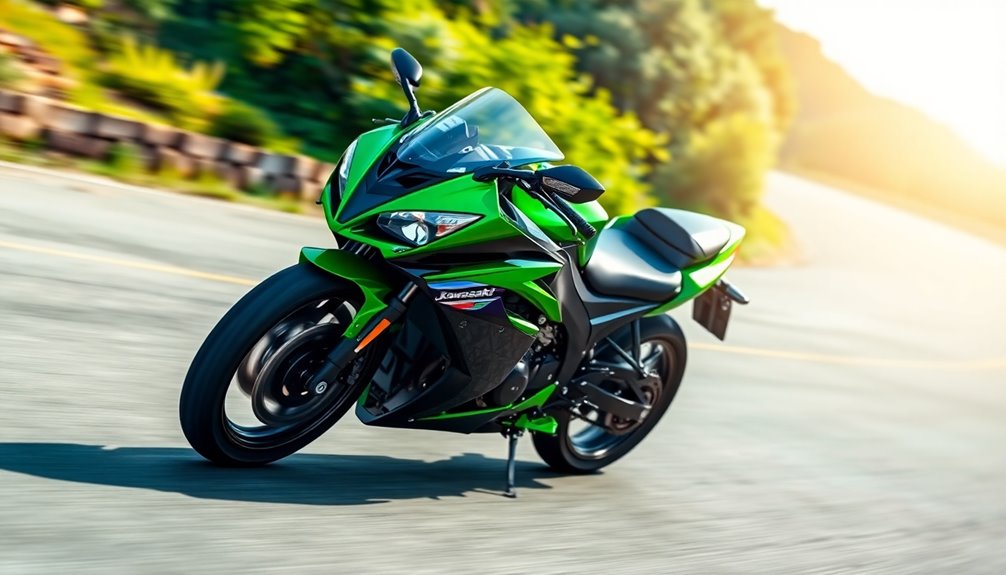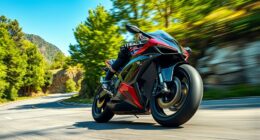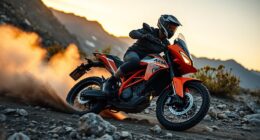The Kawasaki Ninja 400 boasts a thrilling top speed of around 125 mph, making it an ideal choice for new riders craving excitement. Its 399 cc engine delivers 44.8 hp, ensuring strong acceleration and agility. Weighing just 366 pounds, this bike offers impressive handling and rider comfort, perfect for both city rides and weekend adventures. With advanced braking systems and an ergonomic design, you'll feel confident tackling various terrains. Plus, its competitive price makes it an attractive option for beginners. If you're curious about what else this iconic bike has to offer, there's plenty more to discover.
Key Takeaways
- The Kawasaki Ninja 400 achieves a maximum speed of around 125 mph, making it a top choice for new riders seeking performance.
- Most riders can reach 111 mph in about 20 seconds, showcasing its impressive acceleration capabilities.
- With a lightweight design of 366 pounds, the Ninja 400 offers enhanced handling and agility for beginner riders.
- Its powerful 399 cc engine produces 44.8 hp, providing ample power while remaining manageable for less experienced motorcyclists.
- The bike's advanced braking technology and ergonomic design contribute to a safer and more comfortable riding experience for new riders.
Lightweight Chassis Enhances Agility
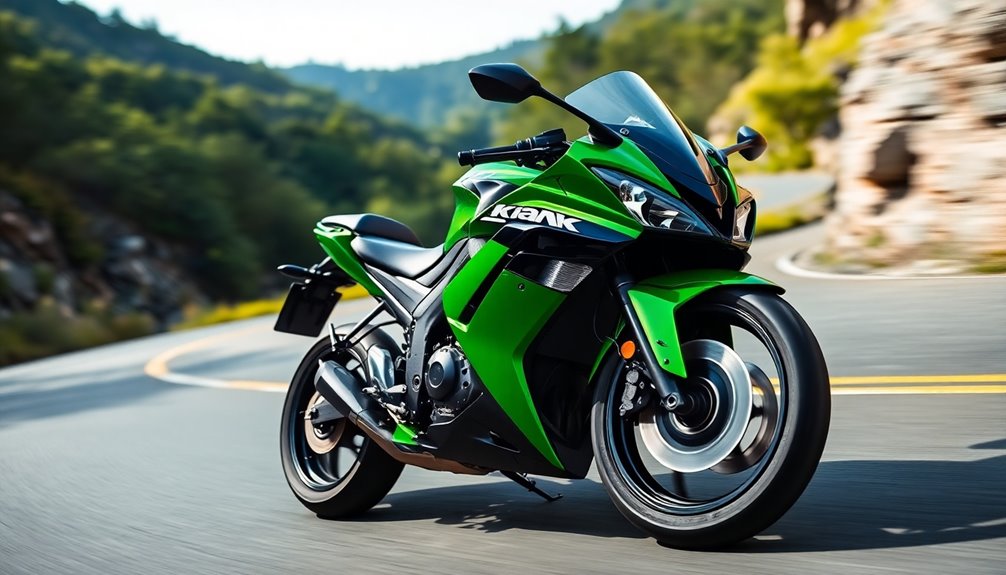
The Kawasaki Ninja 400 features a lightweight trellis frame made from high-tensile steel, which significantly boosts its agility. This design echoes the advanced engineering of the Ninja H2, ensuring you get a motorcycle that's not just robust but also incredibly nimble.
The engine is rigid-mounted and acts as a stressed member, enhancing the overall structural integrity while keeping the weight down. The result is a curb mass of just 168 kg (366 pounds), allowing for effortless maneuverability through traffic and tight corners. The engine's 49 horsepower also contributes to its impressive acceleration and responsiveness.
With a short wheelbase of 1370 mm and a low center of gravity, you'll find handling to be intuitive and responsive. The 140 mm ground clearance facilitates aggressive lean angles, making it easier to tackle sharp turns with confidence.
The lightweight frame complements the bike's steering angle of 35° left and right, providing stability during quick changes in direction.
Moreover, the 120 mm front and 130 mm rear wheel travel enhances your ride quality, especially on uneven surfaces.
Exploring Engine Efficiency
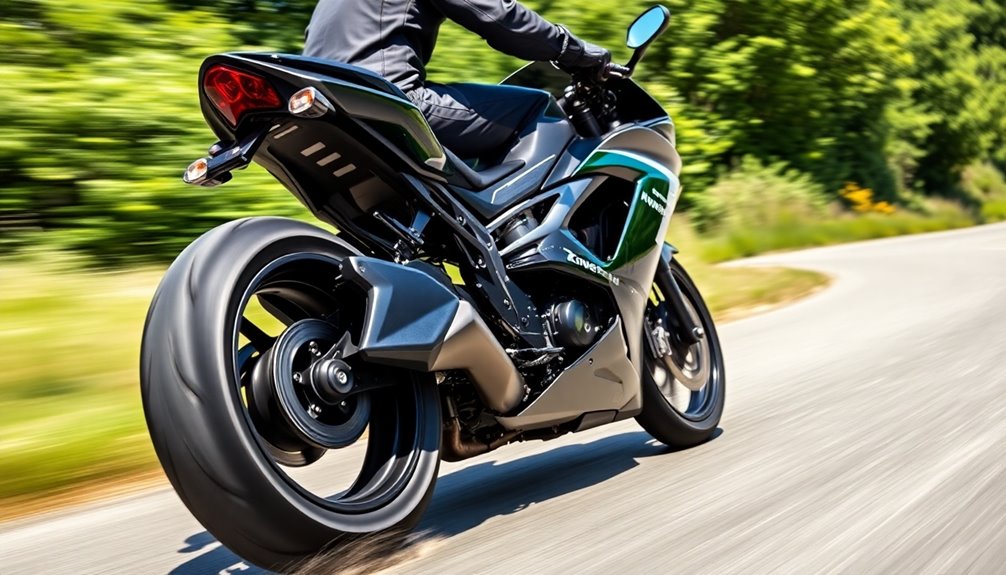
When you hit the throttle on the Ninja 400, the bike's engine efficiency plays a crucial role in reaching a maximum speed of 125 mph.
You'll notice how the aerodynamic design helps reduce drag, allowing you to accelerate to 60 mph in just 4.6 seconds. This combination of power and efficiency makes every ride exhilarating while maintaining optimal performance. Additionally, real-world fuel economy data shows that riders can achieve impressive mileage, further enhancing the riding experience.
Maximum Speed of 125 Mph
Often, riders find themselves impressed by the Kawasaki Ninja 400's potential to reach maximum speeds close to 125 mph, particularly when considering its engine efficiency.
The Ninja 400 is powered by a liquid-cooled, 4-stroke, parallel twin engine with a displacement of 399 cm³. This design, combined with an 11.5:1 compression ratio, allows the bike to deliver a maximum power output of 44.8 hp at 10,000 rpm. Notably, the 2023 model's top speed of 116.7 mph under ideal conditions showcases its impressive performance. To push the limits closer to 125 mph, modifications like a high-performance exhaust system can make a noticeable difference. Achieving this speed typically requires the bike to be in fifth gear, just shy of the redline, and a light rider can help maximize potential.
With an efficient fuel injection system, the Ninja 400 manages a commendable fuel economy of 3.9 l/100 km, proving that power and efficiency can coexist.
To 60 Mph in 4.6 Seconds
Accelerating from 0 to 60 mph in just 4.15 seconds, the Kawasaki Ninja 400 showcases impressive engine efficiency that appeals to both new and experienced riders. This quick acceleration is powered by its 399 cc inline 2-cylinder engine, delivering 44.8 hp at 10,000 rpm and 27 lb-ft of torque at 8,000 rpm.
With a relatively light wet weight of 169 kg, the Ninja 400 achieves a high power-to-weight ratio, which enhances its performance and responsiveness. The bike's acceleration figures stand out, especially when compared to competitors like the Yamaha YZF-R3 and Honda CBR300R, where it consistently outpaces them in 0-60 mph and quarter-mile times. For instance, while the Ninja 400 hits 60 mph in 4.15 seconds, the YZF-R3 lags behind at 5.17 seconds.
This efficiency translates to a thrilling ride, allowing you to experience the bike's capabilities without extensive experience. The gear ratios further optimize acceleration, allowing you to reach impressive speeds quickly. Additionally, the Ninja 400's strong output at higher RPMs ensures that riders can fully exploit its performance potential during spirited rides.
With these features combined, the Ninja 400 isn't just about speed; it's about an exhilarating ride that builds confidence in every twist and turn.
Aerodynamic Design Influence
The Kawasaki Ninja 400's aerodynamic design plays a crucial role in enhancing engine efficiency and overall performance. Its sleek and aggressive bodywork reduces wind resistance, allowing you to slice through the air with ease. The sharp lines and bold graphics not only give it a sporty appearance but also contribute to improved stability at high speeds.
With features like LED headlights and taillights, visibility is maximized, ensuring safety on the road.
Under the skin, the 399cc parallel-twin engine offers balanced performance, thanks to a fuel injection system with dual 32mm throttle bodies that deliver fuel efficiently. This liquid-cooled, 4-stroke, DOHC engine provides smooth and predictable responses, with an impressive 11.5:1 compression ratio for optimal power output. Additionally, the engine produces 44.8 hp at 10,000 rpm, showcasing its robust performance capabilities. Continuous integration practices in development can also lead to improved performance in modern vehicles.
Despite its larger displacement, the engine remains comparable in size to 250cc engines, showcasing its efficient design.
The lightweight trellis frame, mirroring the Ninja H2, enhances agility and handling. Weighing just 366 pounds, it offers a low center of gravity for better maneuverability.
All these elements work together to ensure that the Ninja 400 not only performs well but also feels great to ride.
Rider Comfort on Long Journeys
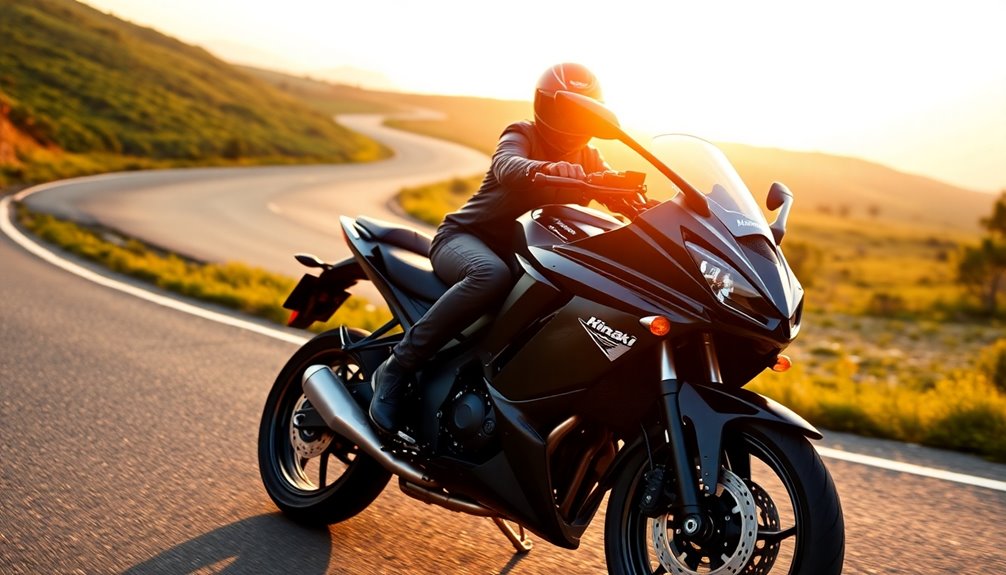
When it comes to long journeys on the Kawasaki Ninja 400, comfort can become a significant concern for riders. The bike's narrow seat and low handlebars create a sporty riding position, which can lead to discomfort after about three hours. While the seat is well-padded and supportive, you might still experience shoulder pain due to the aggressive posture.
Riders around 185 cm (6 feet) tall generally find a comfortable fit, but those under 170 cm might struggle to reach the ground. Taller riders over 6 feet 2 inches may feel cramped, depending on their proportions. The adjustable brake and clutch levers allow you to customize the controls, which can enhance your comfort during longer rides. Additionally, the bike's lightweight design contributes to its agility, making it easier to maneuver during stops.
Although the Ninja 400 handles well with its suspension system and offers good stability, it's best suited for short to medium-distance travel with frequent breaks. Prolonged riding can lead to numbness or soreness in your hands and arms, so planning regular stops is essential.
Ultimately, while the Ninja 400 shines in many areas, it may not be the best choice for marathon rides.
Owner Insights on Performance
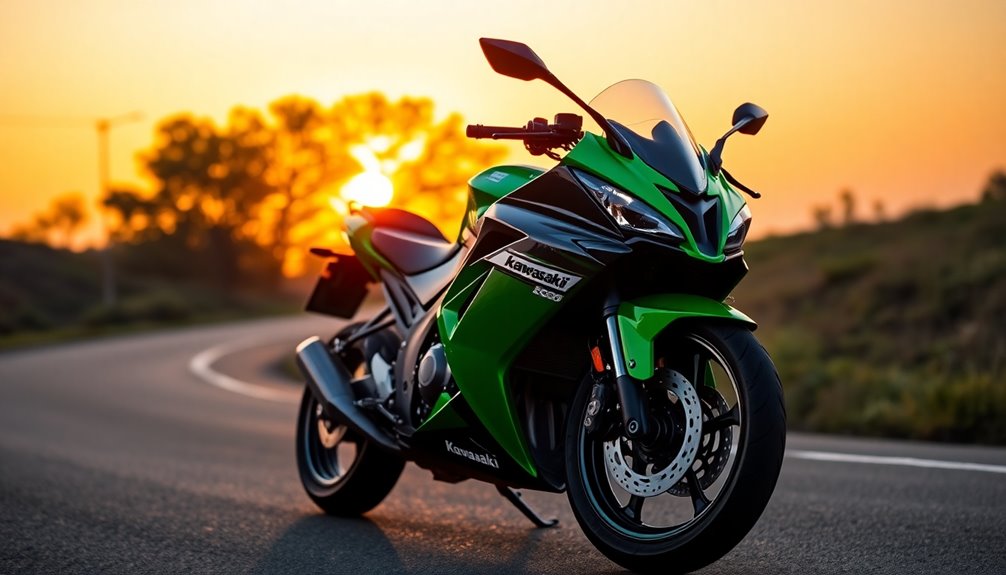
While many owners praise the Kawasaki Ninja 400 for its impressive performance, firsthand experiences reveal a blend of exhilaration and occasional limitations.
You'll likely appreciate the bike's rapid acceleration, hitting 0-60 mph in just 4.15 seconds and reaching 100 mph in under 12 seconds. This quickness makes merging and overtaking on highways feel seamless. Additionally, its fuel efficiency contributes to lower running costs, allowing for extended rides without frequent stops.
However, achieving its top speed of approximately 116.7 mph requires a bit of finesse. You'll need to adopt a jockey tuck and find a long stretch of road. Most riders report hitting 111 mph in around 20 seconds, and with modifications like a good exhaust system, you might push it to 124 mph.
The engine's liquid-cooled, 399 cc parallel twin delivers a robust power output of 45 PS at 10,000 rpm, but you'll find optimal performance above 7,000 rpm.
The bike's low weight and center of gravity enhance handling, making it agile in corners. You'll also enjoy the smooth gear shifting thanks to the assist and slipper clutch.
Market Positioning Against Rivals
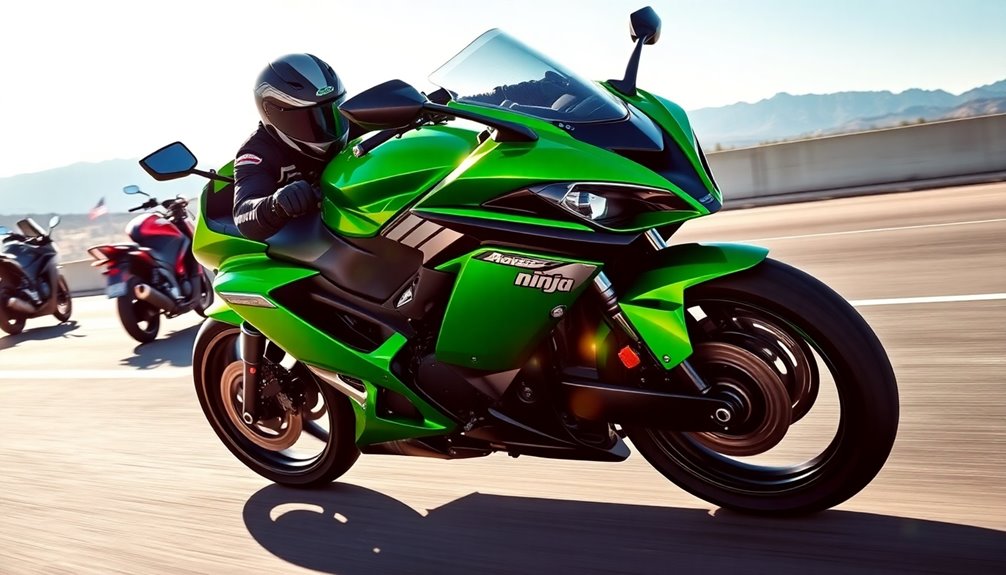
In the competitive landscape of entry-level sport bikes, the Kawasaki Ninja 400 stands out with its blend of performance, accessibility, and value. It appeals to both new and experienced riders, making it an ideal choice for anyone looking to enter the sport-riding scene. With user-friendly features and a comfortable riding experience, it attracts a wide range of enthusiasts. Kawasaki's reputation for reliability and performance further solidifies the Ninja 400's position in the market. Understanding the importance of a good resale value can help buyers make informed decisions when investing in a motorcycle.
The brand's strong legacy, coupled with good resale value, means you're investing in a bike recognized for innovation and a rich racing heritage. At a competitive price of $4,999, the Ninja 400 is more affordable than rivals like the Honda CBR500R, while being similarly priced to the Yamaha YZF-R3. This pricing strategy offers you exceptional value for the performance you get. Additionally, the Ninja 400 achieves approximately 67 mpg in fuel efficiency, making it an economical choice for daily commuting.
With a powerful 399cc engine, light weight, and impressive acceleration, the Ninja 400 outshines many competitors, making it a compelling option for anyone seeking an entry-level sport bike. It's clear that the Ninja 400 is well-positioned against its rivals.
Performance Exhaust System Enhancements
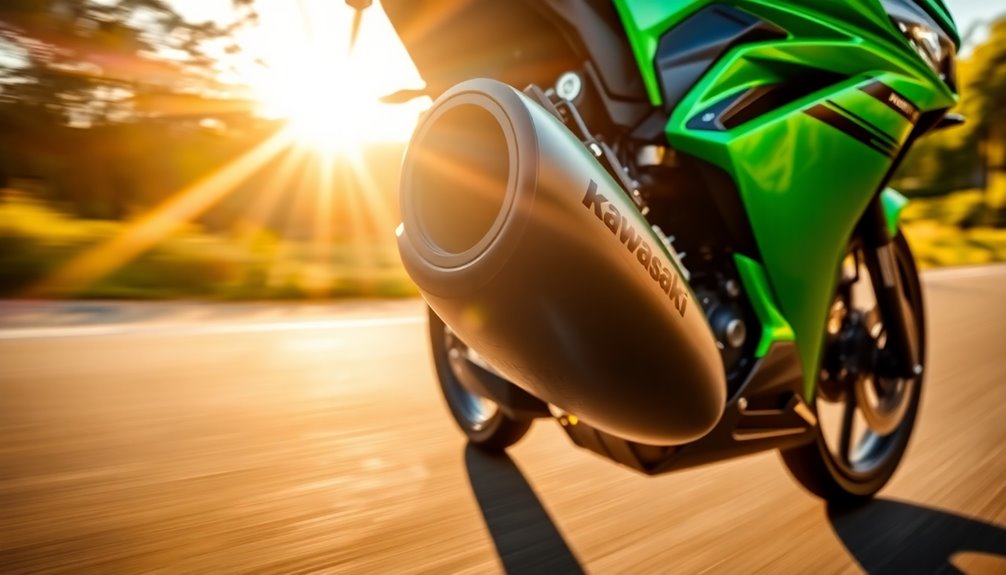
Upgrading the exhaust system on your Kawasaki Ninja 400 can significantly enhance both performance and sound. For instance, the Spark Konix System features a titanium silencer and stainless components, delivering notable horsepower gains when properly dyno tested and paired with ECU remapping. This system is constructed from high-quality materials, ensuring corrosion resistance and durability over time.
If you're after an exhilarating sound, the Two Bros System is engineered specifically for that race experience, while the Coffman's Slip-On not only adds an appealing popping sound but also improves overall sound quality. Most aftermarket systems are designed with handcrafted construction, ensuring quality and performance. While options like the Toce Full System focus on complete upgrades, the Coffman's Slip-On is often praised for its easy installation and compatibility with various setups.
Just remember, some systems, like the Spark Konix, are non-homologated and may not comply with local noise and emissions regulations, especially in California. Before you dive in, consider the noise level and local compliance requirements. By selecting the right exhaust system, you'll unlock your Ninja 400's potential while enjoying a richer riding experience.
Cost Comparison With Competitors
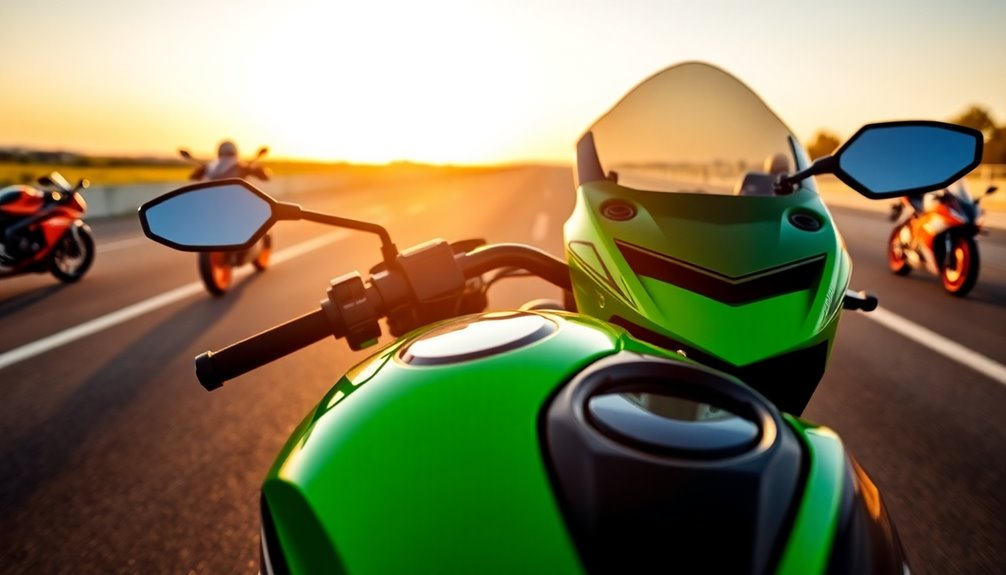
When comparing the Kawasaki Ninja 400 to its competitors, it's clear that pricing and performance play crucial roles in your decision-making process. The Ninja 400 is priced at Rs. 4.69 lakh (about $5,499 for the KRT Edition), which positions it as a mid-range option within the sportbike segment.
In contrast, the KTM RC 390 comes in significantly lower at Rs. 2.34 lakh, making it the most affordable choice. The Yamaha YZF R3 and Benelli 302R fall in between, priced at Rs. 3.48 lakh and Rs. 3.62 lakh, respectively. Notably, the Ninja 400 holds the title of most powerful bike in this comparison, enhancing its appeal for performance enthusiasts. The diversification of retirement portfolio can also be a critical factor when evaluating long-term investments in high-performance bikes. This is similar to how investing in precious metals can enhance portfolio resilience.
If you're considering value for money, the CFMOTO 450SS also retails at around $5,499, similar to the Ninja 400 but offers a slightly higher horsepower.
While the Ninja 400 boasts a powerful 399 cc engine with 44.4 bhp, it's essential to weigh this against the lighter competitors like the KTM RC 390.
Each bike has unique features and performance metrics that affect their overall value. Ultimately, your choice will depend on what aspects—price, power, or handling—are most important to you.
First-Time Motorcycle Enthusiasts
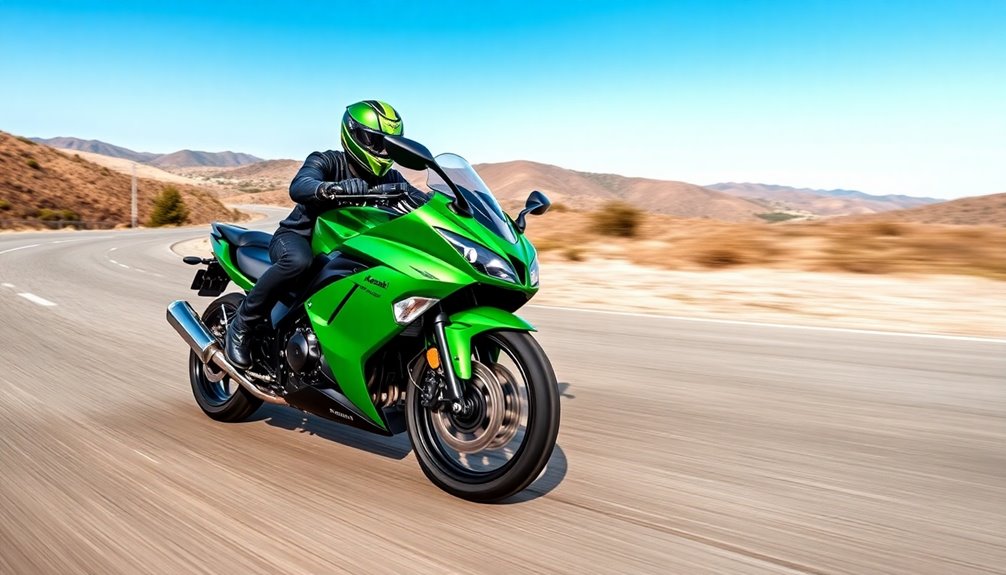
For first-time motorcycle enthusiasts, diving into the world of biking can be both exciting and overwhelming. The Kawasaki Ninja 400 stands out as an ideal entry-level bike, combining performance and user-friendliness.
With a top speed of 116.7 mph, it offers thrilling acceleration that'll get your adrenaline pumping. You can go from 0 to 60 mph in just 4.15 seconds, making it perfect for those who crave a little speed while still feeling in control. The Ninja 400's strong powerband delivers an exhilarating ride, especially post 7000 rpm, providing plenty of power without being intimidating.
Weighing in at 366 pounds, it's light enough for new riders to handle comfortably. Its trellis frame and good ground clearance enhance agility, allowing you to lean confidently into turns.
Equipped with advanced features like a fully digital LCD instrument panel and LED lights, your riding experience will be both modern and safe.
The bike's responsive brakes and well-designed suspension ensure that you can stop and maneuver effectively, giving you the confidence you need as you embark on this thrilling journey into motorcycling.
Maintenance Tips for New Riders
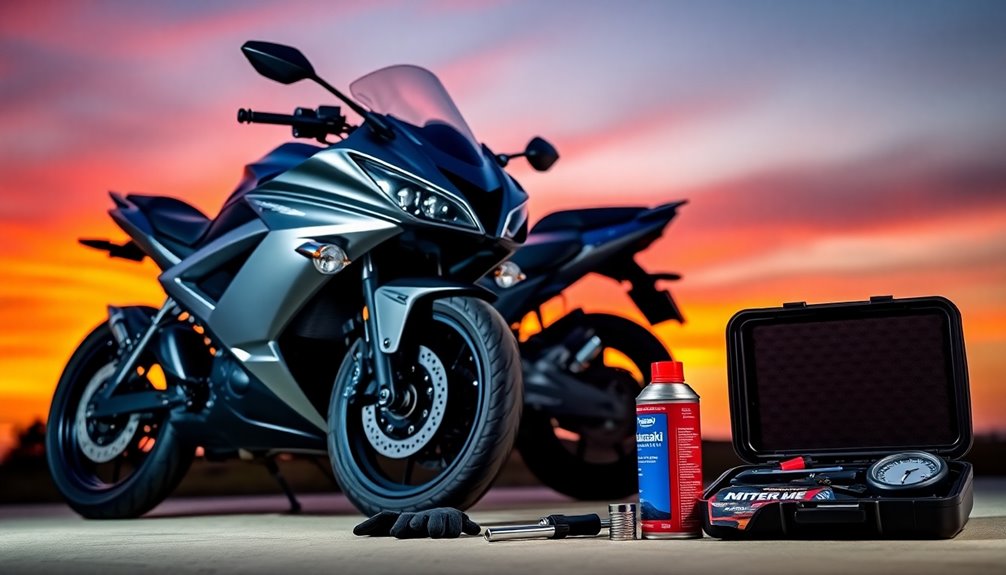
Maintaining your Kawasaki Ninja 400 is essential to ensure a smooth and safe riding experience. Start by changing the oil and filter every 7,600 miles or annually. Use high-quality motor oil, preferably Kawasaki 10W-40, and always replace the oil filter during each oil change for optimal lubrication.
Next, inspect the valve clearance every 15,000 miles and check the engine vacuum synchronization around the same interval. Replace spark plugs as recommended to keep your engine running efficiently. Don't forget to check the engine coolant level regularly. Regular oil changes are essential for optimal performance of your motorcycle.
For your brake system, check the brake fluid level and color frequently. Replace it if it looks discolored, and inspect the brake pads, especially if you ride in challenging conditions. Annual checks on brake operation are crucial for safety.
Chain maintenance is equally important; lubricate the drive chain every 400 miles and adjust the slack every 600 miles.
Inspect the air suction, fuel, and cooling systems for any leaks or damage annually. Lastly, replace the air cleaner element every 7,600 miles or sooner in dusty conditions to keep your bike performing at its best.
Advanced Braking Systems
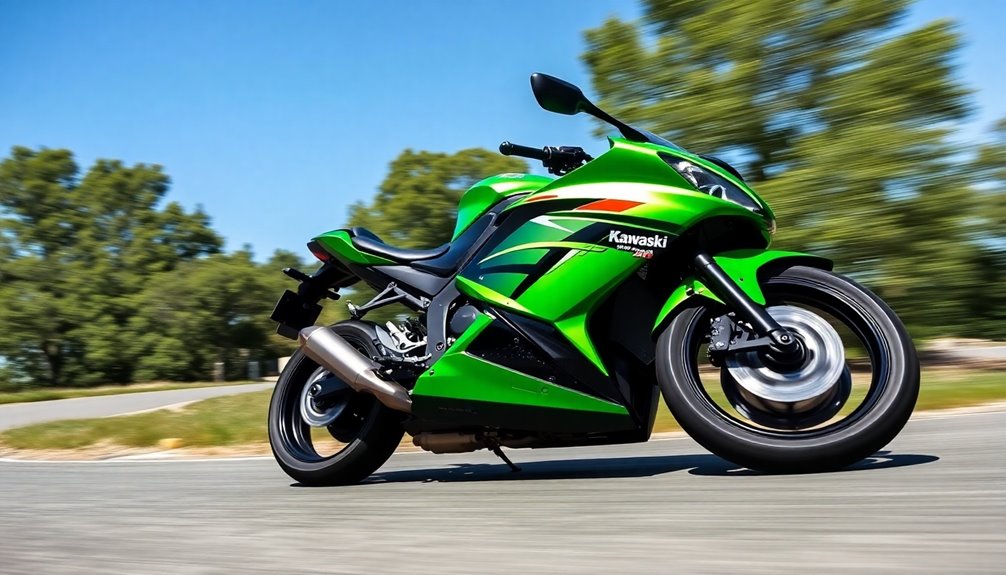
How do advanced braking systems enhance your riding experience? With the Kawasaki Ninja 400, you'll notice the difference right away. The bike features a robust front brake disc measuring 310 mm and a semi-floating petal-type design that ensures effective stopping power. The 2-piston calipers on the front and a single-piston caliper on the rear enhance responsiveness, giving you precise control.
The latest Nissin ABS unit prevents wheel lock-up, especially on low-grip surfaces like wet asphalt or manhole covers. This technology, combined with high precision programming, guarantees reliable performance, boosting your confidence on various terrains. The bike's improved performance across all RPMs contributes to a more dynamic riding experience, allowing you to navigate through various conditions with ease.
The rigid front brake master cylinder minimizes ineffective stroke, while specially selected brake hose dimensions improve your brake feel.
Additionally, Kawasaki's KIBS and K-ACT systems adapt to your riding style, linking front and rear brakes for optimal performance in both sport and touring situations. This adaptability means you can tackle different riding conditions with assurance.
Ideal for Beginner Riders
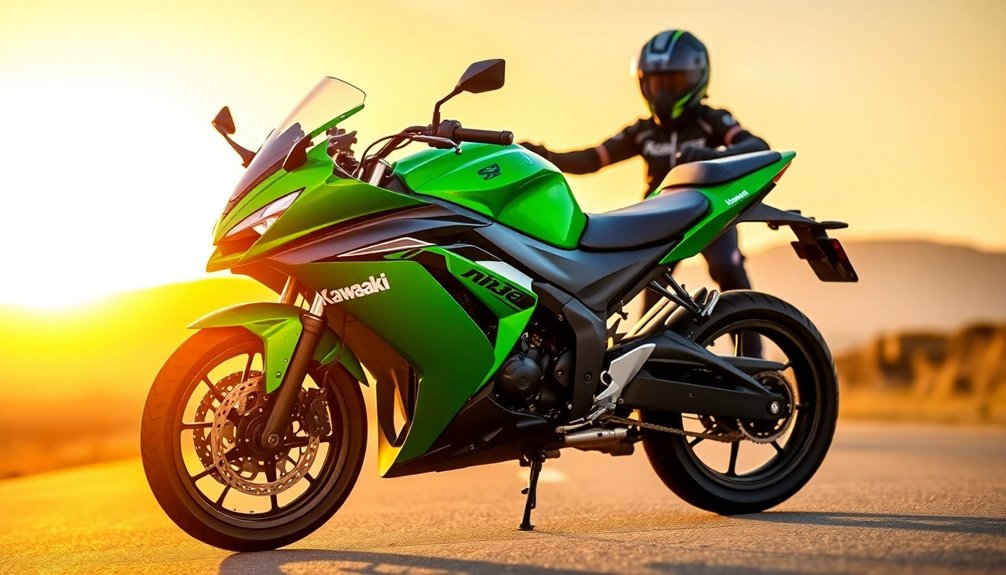
The Kawasaki Ninja 400 stands out as an ideal choice for beginner riders, thanks to its balanced power and user-friendly design. Its 399cc parallel-twin engine produces around 44 horsepower, delivering smooth and predictable power that won't overwhelm you. This manageable torque ensures easy acceleration from a stop, making city commuting and weekend rides enjoyable and stress-free. Additionally, maintaining a healthy weight through regular exercise can enhance your overall riding experience and stamina. It's also important for new riders to practice mindful riding techniques to build confidence and improve safety on the road. Understanding the importance of privacy considerations can also enhance your overall experience when engaging with riding communities online.
Weighing in at around 366-370 pounds, the Ninja 400's lightweight frame and low center of gravity allow for effortless maneuvering. You'll appreciate its responsive suspension and quick steering, which make handling at low speeds a breeze. The compact size also caters to riders of smaller statures, enhancing your confidence on the road. Additionally, the bike is equipped with a standard Anti-Lock Braking System (ABS), which enhances safety during emergency braking situations.
Comfort is key for any new rider, and the Ninja 400 excels here with its ergonomic design. Footpegs and handlebars are positioned for a natural, upright riding stance, reducing fatigue. Plus, the well-padded seat offers excellent support during longer rides. Safety features like the assist and slipper clutch and a digital LCD instrument panel further enhance your control, ensuring that your riding experience is both enjoyable and secure.
Frequently Asked Questions
What Is the Kawasaki Ninja 400's Top Speed?
The Kawasaki Ninja 400's top speed is 116.7 mph, or 188 kph, but you can realistically hit around 111 mph in practical conditions.
If you're looking for more speed, modifications can push it to 124 mph. Just remember, optimal conditions and a long stretch of road are key to reaching those numbers.
With its impressive acceleration, you'll enjoy the ride as you push the limits of this powerful machine.
How Does the Ninja 400 Compare to Its Predecessor?
When you compare the Ninja 400 to its predecessor, the Ninja 300, you'll notice significant upgrades.
The Ninja 400 has a larger 399cc engine, producing 45 HP and 38 Nm of torque, compared to the 300's 39 HP and 27 Nm.
You'll appreciate the improved power delivery and smoother throttle response, making your ride more enjoyable.
Plus, its lighter weight and better ergonomics enhance handling, perfect for new riders like you.
What Is the Weight of the Kawasaki Ninja 400?
The Kawasaki Ninja 400 has a kerb weight of 168 kg, which makes it lightweight and agile.
You'll notice it's about 3 kg lighter than the Ninja 300, enhancing your riding experience.
Its overall design, with a trellis frame and a comfortable seat height of 785 mm, allows you to maneuver easily.
This combination of weight and structure contributes to its impressive handling, making it an excellent choice for both new and experienced riders.
What Type of Fuel Does the Ninja 400 Require?
The Ninja 400 requires a minimum octane of 87, but it's best to use 91 or 93 for optimal performance.
You'll want to avoid ethanol if possible, as it can affect engine health. Make sure you choose high-quality brands like Shell or Chevron to ensure consistency.
With a fuel tank capacity of 3.7 gallons and an average fuel economy of 40 to 60 miles per gallon, you'll enjoy a decent range per tank.
Are There Any Aftermarket Modifications for the Ninja 400?
Yes, there are plenty of aftermarket modifications available for the Ninja 400. You can enhance performance with an ECU reflash, velocity stacks, and upgraded exhaust systems.
For braking improvements, consider steel braided brake lines and upgraded pads. Ergonomics can be optimized with adjustable rear sets and clip-on handlebars.
Don't forget about high-performance tires and suspension upgrades to boost handling. These modifications can significantly enhance your riding experience and overall bike performance.
